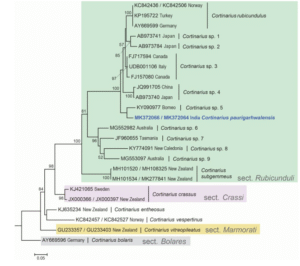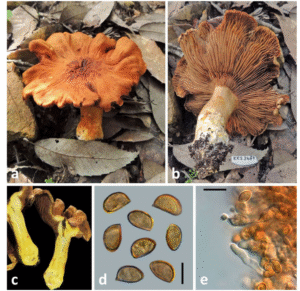Cortinarius paurigarhwalensis Semwal, Dima & Soop, sp. nov.
Index Fungorum number: IF 829294; MycoBank number: MB829294; Facesoffungi number: FoF 04972; Fig. 78
Etymology: The epithet refers to the type locality Pauri Garhwal in India.
Holotype: KCS2487.
Pileus up to 125 mm diam, hemispherical then applanate, surface dry, slightly tomentose, glabrous but centre with distinct radial wrinkles towards margin, red-brown to reddish golden (6B7–6C7), more brownish to light brown (7D8) at centre, margin undulate when mature. Lamellae adnate to subdecurrent, crowded, up to 6 mm broad, lamellulae of various lengths present, greyish brown to greyish orange (6B5–5B5). Stipe 70 × 16 mm, cylindrical, slightly clavate to bulbous, base up to 24 mm broad, greyish orange (6B5–6B6) at apex, paler to whitish towards the base, but staining yellow. Context strongly canary yellow (2B7). Odour and taste not observed. Basidiospores: 6.0–7.5 × 4.0–5.0 µm, MV = 6.5 × 4.3 µm, Q = 1.4–1.6, Qav = 1.5 (n = 40), amygdaloid to broadly amygdaloid, very finely verrucose, almost smooth. Cheilo- and pleurocystidia present, 20–40 × 3–7 µm (n = 10), variable in shape, clavate, subclavate to ventricose, sometimes subcapitate and lageniform. Spore print hazel brown (6E8).
Habitat and distribution: Solitary, occurring in leaf litter of Quercus leucotrichophora and Rhododendron arboreum.
Material examined: INDIA, Uttarakhand, Pauri Garhwal, Phedhkhal, Ulkhagarhi, 2070 m asl, 30°9′36″ N, 78°50′53″ E, 31 August 2015, K.C. Semwal, KCS 2487 (CAL, holotype).
GenBank numbers: ITS: MK372066; LSU: MK372064.
Notes: Cortinarius paurigarhwalensis is the third described species in sect. Rubicunduli besides the European type species C. rubicundulus (Rea) A. Pearson which grows in boreal coniferous forests and C. subgemmeus Soop associated with Nothofagus and Leptospermum in New Zealand. The closest relative of C. paurigarhwalensis based on LSU sequences seems to be a species occurring in Malaysia (Borneo) (marked as Cortinarius sp5 in Fig. 77), but the relationship gained no statistical support in our analysis. Using BLASTn of ITS sequences, the closest species are Cortinarius sp3, and C. rubicundulus differing by > 40 substitution and indel positions from C. paurigarhwalensis. Morphologically, as well as phylogenetically, C. paurigarhwalensis undoubtedly belongs to sect. Rubicunduli sharing characters with the related species such as the orange-brown basidiocarps, the yellowing context, the small, almost nonverrucose spores and presence of conspicuous lamellar cystidia, which is a rare feature in the genus Cortinarius.

Fig. 77 Phylogenetic position of Cortinarius paurigarhwalensis (KCS 2487, holotype) within sect. Rubicunduli inferred from ITS and LSU sequences. Bootstrap support values (ML) ≥ 50% are given near nodes. The tree is rooted with C. bolaris. The new species is in blue

Fig. 78 Basidiocarp and microscopic structures of Cortinarius paurigarhwalensis (KCS 2487, holotype). a–c Basidiocarp. d–e Spores and cystidia. Scale bar: c–e = 10 µm, d = 5 µm
